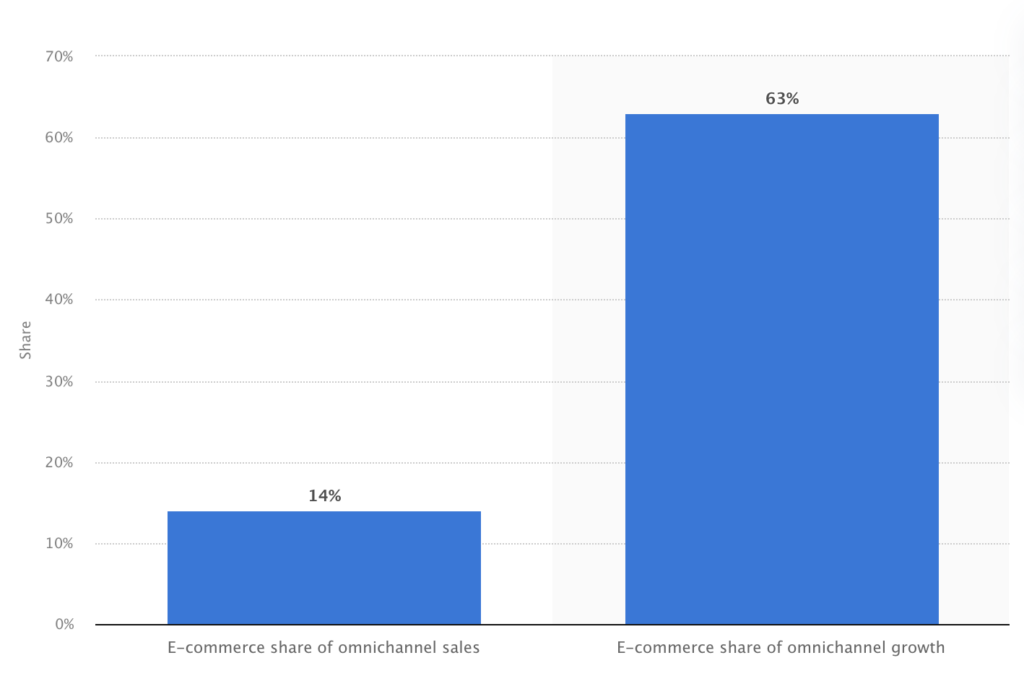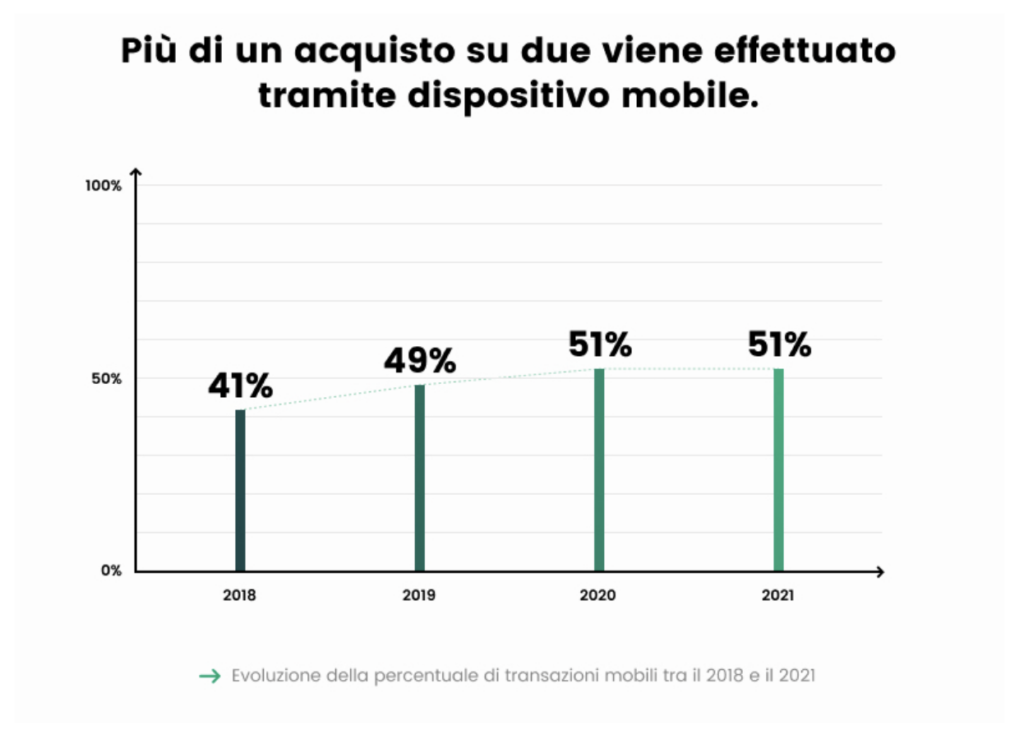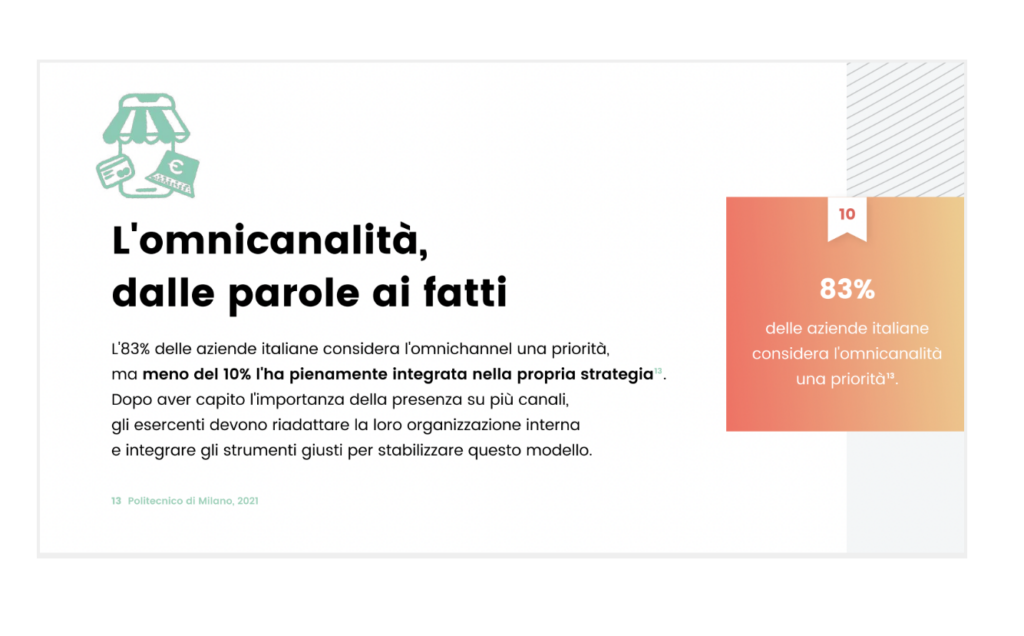Mobile-commerce: rise and forecast
12 April 2022
Definition: The term mobile commerce (m-commerce) means any type of commercial transaction carried out from a mobile device, such as a smartphone, tablet, smartwatch.
mCommerce: when the buying process becomes omnichannel
Among the benefits of mobile are, without a doubt, increasing customer loyalty, this is due to the “purchase history” function that an app holds and thanks to which the company can analyze consumer behavior and then devise ad hoc coupons and discounts or recommend products in line with their preferences. In this way, the shopping experience will greatly improve and also the awareness value, thanks in part to the sending of personalized push notifications, will increase and enhance the relationship between the customer and the brand.
So many building blocks for one important goal: to enhance relationship marketing objectives in order to improve the customer’s shopping experience.
Therefore, in this case it is inescapable to speak of multichannel or omnichannel shopping. A strong upward trend that of multichannel shopping is also evident from the trend in this chart relating to a 2019 survey conducted by
Statista
, which clearly shows that the percentage of omnichannel purchasing is 63 percent.

As a result of the global health crisis and with the optimization of activities across multiple channels, companies and their online stores, can offer customers broader benefits such as, for example, a ‘timely, accurate and personalized customer care experience.
Returning to the present day, to a survey conducted in 2021 by PayPug, the numbers despite the global pandemic and relative to mCommerce seem to confirm the growth trend. In fact, the survey shows that more than one in two online purchases is made via smartphone, proof that mobile is now an integral part of our shopping habits as well.

Although mobile devices are often associated with small purchases, more particularly cosmetics and clothing, it is confirmed instead that they are increasingly being used for major purchases: the 39% of payments over 75 euros are made via smartphone, 7 points higher than in 2019.

[Moreover, transactions carried out in May 2021 show that Italians favor cell phones for weekend purchases (56 percent) and computers for those during the week (51 percent)].
Data that adds to the analysis conducted by
Salesforce
related to the topic of changing customer expectations of the shopping experience. According to this survey, 75 percent of users interested in shopping want a multichannel shopping journey, connected across all platforms.

So when we talk about multichannel platforms, what are we referring to?
There are different types of mCommerce: in fact, it is possible to make purchases through mobile browser (Chrome, Safari, Opera for iOS and Android) or within applications with dedicated sections to online transactions and shopping; think of apps such as Just East, Deliveroo, Amazon, and so on, but also of streaming service platforms that integrate and facilitate online payment for their services.
The use of mobile hardware to finalize a transaction constitutes another important aspect of
mobile commerce
. Applications such as Apple Pay, Google Pay and Samsung Pay make use of the technology Near-Field Communication – NFC-for making contactless payments, or even scanning QR codes, which is another way to pay from the phone and avoid contact.
Thanks to the rapid development of faster connections (4G, 5G), the normalization of the smartphone as an indispensable tool, and finally, due to the global health emergency, mobile commerce has become the preferred mode of online shopping, also affirmed by the 2022 forecast of online shopping trends, conducted by PayPug, which sees Social Media as the new channels of the Marketplace with the 33% of Italian users who use them to find specific products instead of using search engines.
Moreover, payment is no longer understood as a mere activity to collect money, but actively contributes to improving the user experience and enhancing the user’s relationship with the brand, becoming a true cornerstone of the customer journey.
Another key theme for the rise of mCommerce is that of environmental sustainability: in fact, a 50 percent increase in the use of recyclable packaging is expected with regard to all online purchases. At the same time, usable and inclusive digital interfaces designed for people over65 (who account for 51 percent of Italians who use the Internet as a purchasing channel) and people with disabilities (5 percent) are also competing in making e-commerce increasingly easy.
Another widely rising phenomenon is LiveStream Shopping, which is online sales through live video broadcasts. This mode allows an immediate connection with the Community and at the same time enables a large increase in online sales.
So, given the tools available and their potential, what is missing in order to positively record the metrics (KPIs) important to a company, viz.
- Increased conversions
- Average value of the highest order
- Reduced dropout rates
- Higher retention rates
Anyone with an ecommerce business has a goal of improving these metrics. PayPug’s analysis questions in this regard the absence of a multichannel strategy that would limit the positivity of online transactions.

